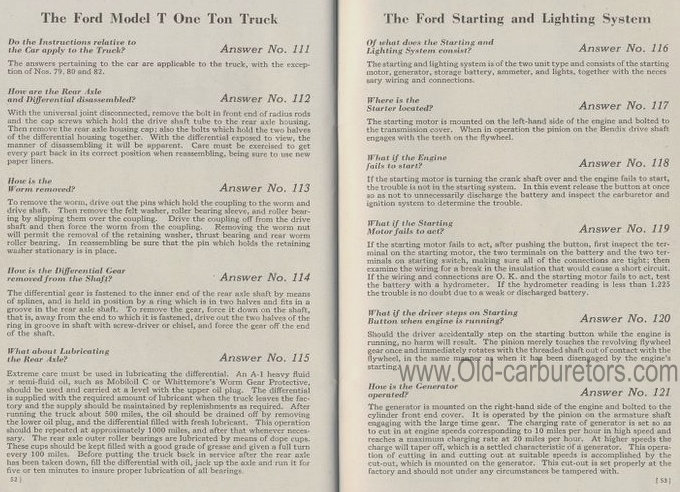Ford Model T One Ton Truck
First |
Previous Page |
Next Page |
Last | Model T Home
The Ford Model T One Ton Truck
Do the Instructions relative to
the Car apply to the Truck? Answer No. 111
The answers pertaining to the car are applicable to the truck, with the exception
of Nos. 79, 80 and 82.
How are the Rear Axle
and Differential disassembled? Answer No. 112
With the universal joint disconnected, remove the bolt in front end of radius
rods and the cap screws which hold the drive shaft tube to the rear axle housing.
Then remove the rear axle housing cap; also the bolts which hold the two halves
of the differential housing together. With the differential exposed to view,
the manner of disassembling it will be apparent. Care must be exercised to get
every part back in its correct position when reassembling, being sure to use
new paper liners.
How is the Worm removed?
To remove the worm, drive out the pins which hold the coupling to the worm
and drive shaft. Then remove the felt washer, roller bearing sleeve, and roller
bearing by slipping them over the coupling. Drive the coupling off from the
drive shaft and then force the worm from the coupling. Removing the worm nut
will permit the removal of the retaining washer, thrust bearing and rear worm
roller bearing. In reassembling be sure that the pin which holds the retaining
washer stationary is in place.
How is the Differential Gear
removed from the Shaft? Answer No. 114
The differential gear is fastened to the inner end of the rear axle shaft by
means of splines, and is held in position by a ring which is in two halves
and fits in a groove in the rear axle shaft. To remove the gear, force it down
on the shaft, that is, away from the end to which it is fastened, drive out
the two halves of the ring in groove in shaft with screw-driver or chisel,
and force the gear off the end of the shaft.
What about Lubricating the Rear Axle?
Extreme care must be used in lubricating the differential. An A-1 heavy fluid
,)r semi-fluid oil, such as Mobil oil C or Whittemore's Worm Gear Protective,
should be used and carried at a level with the upper oil plug. The differential
is supplied with the required amount of lubricant when the truck leaves the
factory and the supply should be maintained by replenishments as required.
After running the truck about 500 miles, the oil should be drained off by removing
the lower oil plug, and the differential filled with fresh lubricant. This
operation should be repeated at approximately 1000 miles, and after that whenever
necessary. The rear axle outer roller bearings are lubricated by means of dope
cups. These cups should he kept filled with a good grade of grease and given
a full turn every 100 miles. Before putting the truck back in service after
the rear axle has been taken down, fill the differential with oil, jack up
the axle and run it for five or ten minutes to insure proper lubrication of
all bearings.
The Ford Starting and Lighting System
Of what, does the Starting and Lighting System consist?
The starting and lighting system is of the two unit type and consists of the
starting motor, generator, storage battery, ammeter, and lights, together with
the neces sary wiring and connections.
Where is the Starter located?
The starting motor is mounted on the left-hand side of the engine and bolted
to the transmission cover. When in operation the pinion on the Bendix drive
shaft engages with the teeth on the flywheel.
What if the Engine
fails to start? Answer No. 118
If the starting motor is turning the crank shaft over and the engine fails
to start, the trouble is not in the starting system. In this event release
the button at once so as not to unnecessarily discharge the battery and inspect
the carburetor and ignition system to determine the trouble.
What if the Starting
Motor fails to act? Answer No. 119
If the starting motor fails to act, after pushing the button, first inspect
the terminal on the starting motor, the two terminals on the battery and the
two terminals on starting switch, making sure all of the connections are tight;
then examine the wiring for a break in the insulation that would cause a short
circuit. If the wiring and connections are O. K. and the starting motor fails
to act, test the battery with a hydrometer. If the hydrometer reading is less
than 1.225 the trouble is no doubt due to a weak or discharged battery.
What if the driver steps on Starting
Button when engine is running? Answer No. 120
Should the driver accidentally step on the starting button while the engine
is running, no harm will result. The pinion merely touches the revolving flywheel
gear once and immediately rotates with the threaded shaft out of contact with
the flywheel, in the same manner as when it has been disengaged by the engine's
starting.
How is the Generator
operated? Answer No. 121
The generator is mounted on the right-hand side of the engine and bolted to
the cylinder front end cover. It is operated by the pinion on the armature
shaft engaging with the large time gear. The charging rate of generator is
set so as to cut in at engine speeds corresponding to 10 miles per hour in
high speed and reaches a maximum charging rate at 20 miles per hour. At higher
speeds the charge will taper off, which is a settled characteristic of a generator.
This operation of cutting in and cutting out at suitable speeds is accomplished
by the cut-out, which is mounted on the generator. This cut-out is set properly
at the factory and should not under any circumstances be tampered with.

